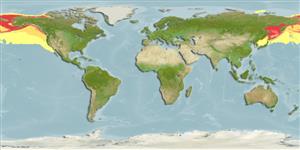Common names from other countries
Classification / Names / Names
Namen | Synonyme | Catalog of Fishes (gen., sp.) | ITIS | CoL | WoRMS
Environment: milieu / climate zone / depth range / distribution range
Ökologie
Bathydemersal. Subtropical; 90°N - 0°S, 126°E - 115°W
Pacific Ocean and the Arctic: Eastern side of Ostrov Sakhalin to northern Hokkaido. Subtropical to polar.
Length at first maturity / Size / Gewicht / Alter
Maturity: Lm ? range ? - ? cm Max length : 170 cm TL Männchen/unbestimmt; (Ref. 1394); 160 cm TL (female); max. veröff. Gewicht: 123.0 kg (Ref. 1394)
Inhabit the southern edges of the pack ice from winter to early summer and coastal areas including river mouths, in late summer and autumn. Diet composition varies with the age of the seal; Newly weaned pups feed on small crustaceans, advance to schooling fishes, larger crustaceans, and octopuses, and finally graduate to bottom dwelling fish and cephalopods (Ref. 1394).
Jefferson, T.A., S. Leatherwood and M.A. Webber. 1993. (Ref. 1394)
IUCN Rote Liste Status (Ref. 130435: Version 2024-1)
CITES Status (Ref. 108899)
Not Evaluated
Not Evaluated
Nutzung durch Menschen
Fischereien: kommerziell
FAO - Fischereien: landings, Artbeschreibung | FishSource | Sea Around Us
Tools
Mehr Information
NamenSynonymeRäuberFortpflanzungGeschlechtsreifeAblaichenFecundityEierEientwicklung
Internet Quellen
Estimates based on models
Preferred temperature
(Ref.
115969): -0.6 - 5.6, mean 2.2 (based on 1984 cells).
Widerstandsfähigkeit
mittel, Verdopplung der Population dauert 1,4 - 4,4 Jahre. (K=0.16-0.44).
Verwundbarkeit
High to very high vulnerability (72 of 100).
Preiskategorie
Unknown.
